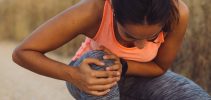Author: Galina V. Roofener MSOM, Dipl. Ac. (NCCAOM)®, Dipl. C.H. (NCCAOM)®, L.Ac., L.C.H., A.P.
The current COVID-19 outbreak is caused by a virus from the same family of viruses that caused SARS in 2002-2003. (Original corona virus -(SARS-CoV)2; Current COVID-19 – (SARS-CoV-2)1). The World Health Organization (WHO) has collected a large number of reputable studies2 on the effectiveness of Traditional Chinese Medicine (TCM) as an integral part of the treatment and prevention of corona virus infections. This resulted in a number of recommendations published in 2004, including the following:
- “Fully utilize TCM resources by bringing TCM into the clinical treatment system for public health
emergencies, establish research networks, prepare plans for responding promptly to SARS outbreaks and for conducting research, and strengthen staff training. - The experiences of treating SARS with integrated TCM and Western medicine described in the 13 clinical reports can serve as a reference for other countries in developing strategies for preventing and treating acute epidemics.”
Sixteen years have passed since these recommendations were initially put forth, yet Western culture has not fully embraced WHO recommendations, nor have they fully adopted Traditional Medicine. One can speculate if it is this difference in prevention and treatment strategies which resulted in Italy’s death rate more than triple that of China as of 02/27/2020. Real time data on COVID-19 is available on https://www.worldometers.info/coronavirus/
Report from China: TCM had been prescribed to 60,107 infected patients, or 85.2 percent, of the total infections nationwide, according to announcement published on 02/20/2020 at the China Daily website https://www.chinadaily.com.cn/a/202002/20/WS5e4e7fafa31012821727915a.html. “A large number of clinical practices have confirmed the effect of the combined treatment of TCM and Western medicine on new coronavirus pneumonia patients,” said Yu Yanhong, Party chief and deputy head of the administration, also a member of the central government work group guiding epidemic control work in Central China’s Hubei province.
Throughout its long history, China has faced many infectious disease epidemics. “There must be around 250 texts written on epidemics from ancient China.3” This vast experience in managing epidemics led to strategies on how to manage infectious diseases at each stage of development and is outlined in Shang Han Lun (Discussion of Cold Damage) and Wen Bing Xue (Warm Disease Theory).
In the United States healthcare model, the role of TCM practitioners will be limited primarily to prevention,
treatment of early stage disease and the recovery after COVID-19 infection in ambulatory patients. Therefore, we can focus on prevention strategies that are in high demand right now.
According to a study published by Luo, et al.1 the approach to “Tonify Wei Qi” or Strengthen Immunity for the prevention of SARS-CoV has been effective. Yu Ping Feng San formula (consistent of Huang Qi (Astragalus membranaceus), Bai Zhu (Rhizoma Atractylodis macrocephalaeand), and Fang Feng (Radix saposhnikoviae)), which has traditional indications to treat those patients with a higher propensity of coming down with the common cold, and can be used with or without modifications. This formula is also affordable and an available resource to prevent infection.
Avoid prescribing Yu Ping Feng San to patients on immunosuppressants without careful patient monitoring by a western medical doctor. Huang Qi (Astragalus) has dose dependent Immunostimulatory effects that may
counteract immunosuppressant medications.
Another well-known application of Yu Ping Fend San is for the treatment of Allergic Rhinitis. This can become an important and beneficial feature to reduce panic when spring blooms are causing symptom aggravation of environmental allergies that maybe mistaken as the start of COVID-19.
It is imperative to instruct patients to stop Yu Ping Feng San formula immediately if feeling ill. Remember, Huang Qi (Astragalus) arrests sweating which contradicts “promote sweating/release the exterior” treatment strategies at initial stages of “Wind” or Upper Respiratory Tract Infection diseases.
It is important to differentiate the TCM Pattern currently being presented by the patient and formulate your
prevention/treatment strategies and dietary advices appropriately. According to the data from China17 most
hospitalized cases present with “Dampness” characteristics. A great resource of experiences from China can befound on the elotus website https://www.elotus.org/. Let us draw on our ancestor’s heritage and the current experience of our colleagues from China in our quest to help patients while also not forgetting to stay within your legal scope of practice!
If any patient meets the corona testing criteria, consider this a RED FLAG and refer these patients to their medical doctor for COVID-19 testing immediately. To find CDC guidelines for healthcare practitioners go to
https://www.cdc.gov/coronavirus/2019-ncov/hcp/index.html
At this time of wide spread panic and world-wide shutdowns, it is our duty as TCM practitioners in the United States to be focused on preventative measures which could mitigate COVID-19 infection, and/or treatment of flulike symptoms at “Tay Yang level”. The moment infection enters deeper levels and fever rises or cough descends into the lungs patient must be referred to their Medical Doctor for additional checkup immediately.
This level of care can be done via telemedicine appointments. The optimal way to deliver herbs to our patients during the current social distancing mandate is to direct ship formulas to the patient from a third party dispensary. There are multiple options for herbal manufacturers and distributors that are considered essential businesses and will remain open during COVID-19 epidemics and will drop ship herbs to patients.
If you prefer to sell herbal formulas directly from your office, refer to your state practice law as many states have suspended non-essential businesses operations. Follow CDC recommendation on social distancing: collect credit card payment, confirm the time the patient will arrive via phone or other secure communication and put the ready to pick up herbal prescription outside your door.
At this difficult time, beside offering herbs to our patients we also must calm the anxiety patients are experiencing. There is some very interesting statistics about pandemics through history at the Visual Capitalist website (www.visualcapitalist.com/history-of-pandemics-deadliest/). The good news is that compared to the Bubonic Plague of 1347-1351 this pandemic is mild, so far. We are fortunate, our government very early has taken every possible measure to save as many life’s as possible. Our duty is to follow CDC and government guidelines to prevent spread of disease, even if shutdown is devastating for our financial wellbeing.
You can find information on how to conduct telemedicine appointment in a manner compliant with professional standards, Federal & State legal requirements and HIPAA regulations at (www.asiantherapies.org/telemedicine) Studies below are to illustrate evidence of Traditional Chinese Herbal Medicine effectiveness. Please share it with our western medicine colleagues. We can help!
References
1. https://pubmed.ncbi.nlm.nih.gov/32065348/ Can Chinese Medicine Be Used for Prevention of Corona Virus Disease 2019 (COVID-19)? A Review of Historical Classics, Research Evidence and Current Prevention Programs Hui Luo 1 2, Qiao-Ling Tang 3, Ya-Xi Shang 2 3, Shi-Bing Liang 2 3, Ming Yang 2 3, Nicola Robinson 2 4, Jian-Ping Liu 5 6
2. https://apps.who.int/medicinedocs/en/d/Js6170e/3.html
Link above contains multiple studies that served as a basis for: Report of the International Expert Meeting to review and analyse clinical reports on combination treatment for SARS. (2004; 194 pages)
Essential Medicines and Health Products Information Portal. A World Health Organization resource.
3. https://www.sciencedirect.com/science/article/pii/S1201971207000355
International Journal of Infectious Diseases Volume 11, Issue 4, July 2007, Pages 360-364 History of Infectious Diseases What happened in China during the 1918 influenza pandemic? K.F.ChengP.C.Leung
4. https://www.ncbi.nlm.nih.gov/pmc/articles/PMC3823765/
PLoS One. 2013; 8(11): e78622. Published online 2013 Nov 11. doi: 10.1371/journal.pone.0078622
Yu Ping Feng San, an Ancient Chinese Herbal Decoction Containing Astragali Radix, Atractylodis Macrocephalae Rhizoma and Saposhnikoviae Radix, Regulates the Release of Cytokines in Murine Macrophages Crystal Y. Q. Du, 1 , 2 Roy C. Y. Choi, 1 Ken Y. Z. Zheng, 2 Tina T. X. Dong, 1David T. W. Lau, 1 and Karl W. K. Tsim
5. https://www.ncbi.nlm.nih.gov/pubmed/25586308
Phytother Res. 2015 May;29(5):656-61. doi: 10.1002/ptr.5290. Epub 2015 Jan 14.
Yu Ping Feng San, an Ancient Chinese Herbal Decoction, Induces Gene Expression of Anti-viral Proteins and
Inhibits Neuraminidase Activity. Du CY1, Zheng KY, Bi CW, Dong TT, Lin H, Tsim KW.
6. https://pubmed.ncbi.nlm.nih.gov/28667937/
J Pharm Biomed Anal. 2017 Oct 25;145:219-229. doi: 10.1016/j.jpba.2017.03.049. Epub 2017 Jun 15.
Metabolic profiling of the traditional Chinese medicine formulation Yu Ping Feng San for the identification of
constituents relevant for effects on expression of TNF-α, IFN-γ, IL-1β and IL-4 in U937 cells. Nikles S1, Monschein M1, Zou H2, Liu Y2, He X3, Fan D4, Lu A5, Yu K6, Isaac G6, Bauer R7.
7. https://www.ncbi.nlm.nih.gov/pmc/articles/PMC5430552/
Sci Rep. 2017; 7: 935. Published online 2017 Apr 20. doi: 10.1038/s41598-017-01110-x
Antiviral activities of Schizonepeta tenuifolia Briq. against enterovirus 71 in vitro and in vivo
Sin-Guang Chen, 1 Mei-Ling Cheng, 2,3,4,5 Kuan-Hsing Chen, 6 Jim-Tong Horng 7,8,9 Ching-Chuan Liu, 10,12 Shih-Min Wang, 10,11,12 Hiroaki Sakurai, 13 Yann-Lii Leu, 14,15,16 Shulhn-Der Wang, 17 and Hung-Yao Ho 3,5,1
8. https://pubmed.ncbi.nlm.nih.gov/31514984/
Chin J Nat Med , 17 (7), 525-534 Jul 2019 Chinese Medicine Yu-Ping-Feng-San Attenuates Allergic Inflammation by Regulating Epithelial Derived Pro-Allergic Cytokines Xiao-Tong Wang 1, Hai-Liang Liu 1, Xi Yu 1, Can Wang 1, Li-Li Gui 1, Xiao-Yu Wang 1, Yong-Qing Hua 1, Jie Zheng 1, Min Hong 2
9. https://pubmed.ncbi.nlm.nih.gov/25198676/
PLoS One, 9 (9), e107279 2014 Sep 8 e Collection 2014 Screening Active Components From Yu-ping-feng-san for Regulating Initiative Key Factors in Allergic Sensitization Dandan Shen 1, Xuejian Xie 2, Zhijie Zhu 3, Xi Yu 3, Hailiang Liu 3, Huizhu Wang 3, Hongwei Fan 4, Dawei Wang 5, Guorong Jiang 6, Min Hong 3
10.https://pubmed.ncbi.nlm.nih.gov/30972189/
Am J Transl Res, 11 (3), 1635-1643 2019 Mar 15 eCollection 2019 Restoration of Immune Suppressor Function of Regulatory B Cells Collected From Patients With Allergic Rhinitis With Chinese Medical Formula Yupingfeng San Cai-Jie Zhou 1, Fei Ma 2, Wen-Jing Liao 2, Li-Juan Song 2, Dian Yu 3, Yan-Nan Song 3, Tian-Yong Hu 4, Zhi-Qiang Liu 4, Zhi-Gang Liu 3, Xiao-Wen Zhang 2, Ping-Chang Yang 3
11.https://www.sciencedirect.com/science/article/pii/S0166354212002367?via%3Dihub
Antiviral Research Volume 97, Issue 1, January 2013, Pages 1-9
Traditional Chinese herbal medicine as a source of molecules with antiviral activity TingLiTaoPeng
12. https://pubmed.ncbi.nlm.nih.gov/15288617/
Journal of Clinical Virology 31 (2004) 69–75
Short communication In vitro susceptibility of 10 clinical isolates of SARS coronavirus to selected antiviral
compounds
F. Chen a, K.H. Chan b, Y. Jiang c, R.Y.T. Kao b, H.T. Lu a, K.W. Fan a, V.C.C. Cheng b, W.H.W. Tsui b, I.F.N. Hung b, T.S.W. Lee b, Y. Guan b, J.S.M. Peiris b, K.Y. Yuen b,∗
13.https://www.ncbi.nlm.nih.gov/pubmed/12814717
Lancet. 2003 Jun 14;361(9374):2045-6.
Glycyrrhizin, an active component of liquorice roots, and replication of SARS-associated coronavirus.
Cinatl J1, Morgenstern B, Bauer G, Chandra P, Rabenau H, Doerr HW.
14.https://pubmed.ncbi.nlm.nih.gov/15288617/
J Clin Virol, 31 (1), 69-75 Sep 2004
In Vitro Susceptibility of 10 Clinical Isolates of SARS Coronavirus to Selected Antiviral Compounds
F Chen 1, K H Chan, Y Jiang, R Y T Kao, H T Lu, K W Fan, V C C Cheng, W H W Tsui, I F N Hung, T S W Lee, Y Guan, J S M Peiris, K Y Yuen
15.https://pubmed.ncbi.nlm.nih.gov/31569633/
Molecules, 24 (19) 2019 Sep 27
Unraveling the Molecular Mechanism of Traditional Chinese Medicine: Formulas Against Acute Airway Viral
Infections as Examples
Yi Shin Eng 1, Chien Hsing Lee 2 3, Wei Chang Lee 4, Ching Chun Huang 5, Jung San Chang 6 7
16.https://pubmed.ncbi.nlm.nih.gov/26645032/
Virusdisease, 26 (4), 225-36 Dec 2015
Herbal Plants and Plant Preparations as Remedial Approach for Viral Diseases
Rajesh Kumar Ganjhu 1, Piya Paul Mudgal 1, Hindol Maity 1, Deepu Dowarha 1, Santhosha Devadiga 1
, Snehlata Nag 2, Govindakarnavar Arunkumar 1
17.https://clinicaltrials.gov/ct2/show/NCT04306497?cond=%22wuhan+coronavirus%22&draw=2&rank=5
18.https://www.elotus.org/promo-files/COVID-19_resources/Handbook_of_COVID_19_Prevention_en_Mobile.pdf
Galina V. Roofener MSOM, Dipl. Ac. (NCCAOM)®, Dipl. C.H. (NCCAOM)®, L.Ac., L.C.H., A.P. is board
certified and licensed in Ohio and Florida to practice Oriental medicine.
Galina can be contacted via email at GR@AsianTherapies.org
 FAST & FREE 2-DAY DELIVERY
FAST & FREE 2-DAY DELIVERY





